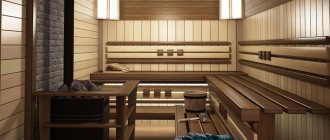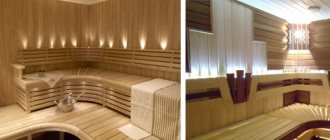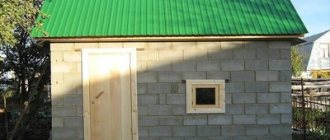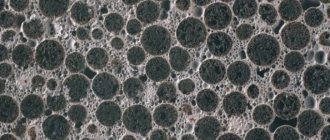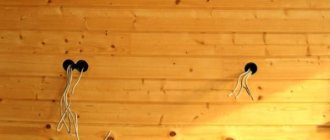Many of those who decide to get a bathhouse on a country site opt for foam blocks. This is a lightweight and cheap material that you can handle even without being a professional. And yet, its features require careful attention to detail: if you do not want to freeze, it is better not to neglect the recommendation to use special glue instead of a cement mixture, and priming and waterproofing cannot be excluded from the list of finishing works, because this is fraught with destruction of the foam blocks.
The reasons for these requirements lie in the physical properties - the cement mixture has different thermal insulation indicators, and for glue they are close to foam concrete, while water is easily absorbed by its porous structure, which is why walls made of this material need protection. By the way, in addition to waterproofing, thermal insulation will not hurt.
The last two points relate to finishing work. Let's take a closer look at how to decorate a bathhouse made of foam blocks inside and out. Let's start with the interior work. This article about foam block baths, their finishing, photos will help you too.
Finishing a bathhouse from foam blocks inside
General finishing requirements
The main requirement for finishing is to improve the appearance of the building.
But there is also a technical goal of finishing, which is to ensure that finishing materials do not affect the performance characteristics of the wall material, or improve them. In particular, the finish should have good vapor permeability, but at the same time low water absorption values .
Useful video
Look at different finishing options in many baths, this will help you decide on your desires and see interesting ideas:
General principles of cladding foam block walls from the inside
Since this article is about a bathhouse, which refers to heated rooms where there is simultaneously high humidity and temperature, it is recommended to install a vapor barrier indoors. Suitable for this:
- foil (it is completely vapor-tight)
- rolled bitumen materials
- ceramic tiles with joints made of silicone sealants.
You can also use impregnation of the walls with drying oil, oil putty or cold bitumen mastics.
We can offer this option for simultaneous vapor and heat insulation of foam blocks in a bath:
- First, unimpregnated paper is placed on top of the walls.
- Then a layer of thermal insulation (for example, mineral insulation).
- The next layer is a vapor barrier made of foil paper, which will prevent the insulation from getting wet. By the way, the joining of pieces of such foil is always done overlapping and glued with aluminum tape.
Thanks to the listed measures, vapor permeation of the walls is prevented, which means that condensation will not form in them, which contributes to their destruction.
When everything necessary for reliable vapor barrier of the foam concrete box of the future bathhouse has been done, you can begin further finishing, which is responsible for the attractive appearance of the premises.
Finishing foam block in a bath with clapboard
Wood in a bathhouse is the most attractive finishing material, which, unfortunately, has disadvantages and limitations in use.
Thus, lining made from softwood cannot be used in rooms with elevated temperatures, as this releases sticky resins . And high humidity on wood without treatment can lead to mold .
Antiseptic eliminates this , but in general it is advisable to use the lining in the steam room and relaxation room, but not in the washing room. By the way, cheap pine lining can be used indoors for recreation. And in the steam room/sauna you need hardwood, the best of which, according to some, is oak. But most often they use aspen.
If you treat wood correctly, then you can’t think of a better finish for a bathhouse - it is fragrant, environmentally friendly, and healthy - due to the phytoncides released by some species.
The process of finishing a bathhouse with clapboard
- Bring the clapboard to the bathhouse in advance - its humidity should be equal to the humidity of the environment.
- Electrical wiring and other communications must be completed before installation.
- A wooden sheathing is made on the walls of the bathhouse (it is better to use special dowels specifically for foam blocks and self-tapping screws) and coated with an antifungal compound.
- The space between the sheathing and the wall is filled with insulation.
- The vapor barrier material is attached to the sheathing with a stapler.
- The lining itself can be attached to the sheathing either with nails or with hidden clamps. The latter are used for decorative finishing.
Finishing foam block in a bathhouse with tiles
Tile is an inexpensive, durable material that you can install yourself. In bathhouses it is used for walls and floors, more often in a washing room, where the wood will rot. To avoid injury in the future, you should choose rough rather than smooth tiles. The base is better smooth - it will not pick up water and will not give mold a chance to multiply. Of the tiles with and without enamel, the first one is better. At least parts of the walls can be finished with soapstone tiles.
Useful video
In the video below, see how you can decorate it beautifully, even inexpensively, with substandard tiles. The builder shares:
Tile laying process
- The surface must be completely cleaned of dust and debris, moistened with a cleaning agent and leveled.
- Prime with primer for foam blocks.
- Next, the surface is waterproofed.
- The solution is mixed and applied with a comb spatula.
- The tiles are laid with cross separators to ensure equal spacing between the tiles.
- The seams are sealed with grout using a special trowel.
- Once the work is completed, the tiles can be treated with an anti-mold solution.
Finishing with PVC panels
The main advantage of PVC panels is their low cost . You can also point out the ease of installation and maintenance in the future. PVC is not afraid of humidity and temperature changes. This is a good option for washing in a bathhouse.
The process of laying PVC panels
For a bathhouse, it is better to place the panels not on the wall, but on the crate. The stages of the process are similar to those described in the paragraph on finishing with clapboard, only instead of it, at the last stage, PVC panels are attached to the sheathing.
In addition to walls, plastic panels can be used for ceiling cladding. It is necessary to take into account that lamps located close to such a ceiling can damage the plastic when the lamps heat up . It is better to use low-watt point light sources.
When installing plastic on the ceiling, you will need to secure the insulation so that it does not hang between the beams. For this purpose, a cord is suitable, which is attached to the beams, forming a mesh for the insulation.
As you can see, the interior decoration of a bathhouse made of foam blocks allows for many options to make it beautiful and cozy.
Project
Just as for any construction, before you start building a bathhouse, you need to choose a location, carefully plan, select and calculate the necessary material. Also find out what the roof will be like, for example, pitched.
It is advisable to immediately imagine what you want to see in the layout of your bathhouse. In the classic version, the drawings of almost all baths include a steam room and a sink; a relaxation room is also desirable. In different cases, areas are distributed according to emerging requests. There may be options with a large steam room and a small sink, also with reverse distribution, a large relaxation room is possible and many other options.
Choosing the appropriate option will not be difficult. Each person has his own idea of the functionality, proper use and organization of the premises of the building being built.
Particular attention should be paid to the construction of the vestibule if you plan to use the bathhouse for its intended purpose in winter
Also, the location of the doors is of no small importance; they must be planned so as not to take up too much space.
The stove must be selected taking into account the volume of the steam room, not forgetting that it is usually heated from the dressing room, therefore, part of the heat is spent on heating it. Based on these parameters, the furnace power is selected.
Currently, the bathhouse serves not only for washing, it is often used for emotional and psychological relief. Based on the requirements, a construction project is selected and implemented.
It may include not only the classic set: steam room, wash room, locker room, but it may also include the premises of a relaxation room, terrace, attic, swimming pool.
The most economical option would be to implement a project to build a bathhouse with three rooms.
There are a great variety of bathhouse designs, the most common of which are those where the rest room is combined with a locker room. At the same time, it is advisable to make it larger than other rooms, due to the placement of the necessary furniture in it.
Plans for bathhouses with terraces are very common. The terraces are equipped with the necessary furniture in the form of chairs and tables, barbecues and barbecue ovens are installed. The building is built under a single roof and has an appropriate design. Instead of a terrace, you can add, for example, a garage or another extension. The original idea is a country house combined with a bathhouse building.
Quite often, an attic is built as a second or third floor. This two-story building can be used as living or guest rooms or for relaxation after procedures. Such structures can also be one-story. The most commonly used sizes are 6 by 4, 3 by 5, and 6x6 meters.
You need to approach the selection of a construction site with all responsibility. The site must comply with all fire safety rules and the requirements of SNiP 30-02-97.
Based on these requirements, the building must be located at a distance of one meter from the fence, while the distance to the neighboring house must be at least eight meters, including five meters to the border of the site.
FINISHING foam blocks OUTSIDE
General principles of exterior cladding
What was said above about the aesthetic and technical purposes of interior decoration also applies to exterior decoration. When using a material such as foam blocks, there is a need for its hydro- and sometimes thermal insulation from the outside too.
There are practically no differences in installation: the same wooden frame, which is attached to the wall (again, let us remind you about specialized dowels for foam blocks and self-tapping screws) and serves as cells for filling them with heat insulator. A layer of waterproofing is applied on top and the last layer is decorative.
Today on sale you can find a material that successfully combines heat preservation and moisture protection - this is foil foam, the basis of which is foamed polypropylene, covered with aluminum foil and sprayed levsan. However, you can give preference to mineral wool and conventional wind protection.
The differences begin with the choice of decorative finishes. The future owner of a bathhouse has enough options - this includes siding, and the same lining, made either of wood or plastic, imitation timber and a block house.
Siding finishing
This material consists of panels made of plastic, ceramic or metal with convenient fastening. The length upon purchase is from 2 to 6 meters, and the width is from 10 to 30 centimeters. On one side there is a perforated edge, which is convenient for driving nails into.
This material has two profiles: “herringbone” and “ship plank”, which means one or two fractures in the relief. The textures are different, often imitating natural materials.
Vinyl siding
Made from PVC. The material is not flammable, but melts in a fire. Does not require painting, protects the house from precipitation, is not afraid of large temperature differences, and is inert to many chemical influences. Plastic does not rot and is not of interest to rodents. It has many shades, of which the brightest ones are the most expensive - due to expensive additives that prevent fading.
It can be mounted both horizontally and vertically; the latter mount is called “soffit” and is used for lining roofs.
Metal siding
Stronger than the previous one and does not melt from fire. Made from aluminum or galvanized steel. Due to its low weight it can be used not only in low-rise construction. The fastenings are hidden, it looks seamless, which is good for facades. Dark-colored panels get very hot on a sunny day.
Ceramic siding
Made from fiber cement. Not afraid of fire, cold, or dirt . Externally it can imitate wood, stone and brick. Duration of service - up to 30 years. It does not fade in the sun, as they claim (although, frankly speaking, it is only a matter of time).
In addition, there is also a special type of siding used for cladding plinths. It is distinguished by increased strength and other improved characteristics, since the base heats up in the sun in the summer and gets wet under the sticking snow in the winter.
Whichever of the listed types is chosen, installation is carried out in the same way. An option could be a frame made of metal rather than wood.
Siding Alternatives
- imitation timber is a type of lining made of wood, but larger in width. It looks natural, like a bathhouse built from real timber, if you use coniferous lining 15 cm wide and 1 cm thick.
- block house is another type of imitation timber, only cylindrical. The great advantage of this natural material is that it is dried during manufacturing and is supplied with a humidity level of up to 12%.
- plastic lining is a cheap material with many disadvantages, which today is being successfully replaced by siding.
Using siding
Siding installation diagram.
Siding has long been used for interior finishing work. It has similar technical characteristics to plastic. Only there are much fewer texture and color options. For the most part, it is made in the form of logs, which allows you to create the appearance of a wooden structure. Before installing siding, it is necessary to insulate the walls made of foam concrete. For this you can use the following materials:
- polystyrene foam or polyurethane foam;
- mineral wool;
- waterproofing film.
The use of these materials will allow for high-quality insulation of the walls of the bathhouse. After insulation, you can proceed to the siding installation process. These works are carried out similarly to the installation of plastic panels. The only difference will be that the fastening must be done only with the help of self-tapping screws. This is due to the fact that siding has more weight, and fastening with a stapler will be unreliable.
The advantage of siding is that it has a denser structure, does not burn and does not lose its color saturation during long-term use. In addition, it does not deform under heavy physical stress.
WALL INSULATION
Much has been said about wall insulation above - it is necessary if you do not want to spend a lot of fuel on maintaining the required temperature in the bathhouse and if the thickness of the foam concrete blocks is not enough for your region. Often, when using blocks 20 or 30 centimeters thick, additional insulation is not necessary.
- The most environmentally friendly material for this purpose remains mineral wool, which has other advantages besides the fact that it does not emit harmful substances: it does not grow mold, it does not support combustion and retains heat perfectly.
- In addition to it, there is also cheap polystyrene foam or polystyrene. It is usually glued to the wall, then reinforced with mesh and plaster is placed on top. It can be used for baths, but its vapor permeability is lower than that of mineral wool.
- Bath walls can be insulated with basalt and stone insulation. They have excellent insulating properties, they are also environmentally friendly, non-flammable and (as a plus) mice do not like them.
- Glass wool can also insulate a bathhouse, but it cannot be used on the walls of a steam room - over time it will not withstand its temperatures.
As you can see, the choice of foam blocks as the basis for building a bathhouse has many consequences arising from the characteristics of this material, in particular, its readiness to absorb water. Compliance with the above rules will completely eliminate this drawback. Finishing a bathhouse from foam blocks makes this building material a very suitable option when it comes to choosing materials for building bathhouses.
Roof cladding
To finish the roof in a steam room, it is advisable to use corrugated sheets. This material is made from high quality galvanized sheet steel. At the production stage, each sheet is processed in roll forming machines. The corrugated sheet is protected from corrosion by a galvanized layer.
Stages of building a bathhouse roof from corrugated sheets:
- A sling system is installed.
- A sheathing is installed, which is coated with an antiseptic compound that protects the product from rotting under the influence of moist air and high temperature.
- Wooden surfaces are coated with paint that has fire retardant properties.
- Thermal insulation is being installed. This ensures protection of the corrugated sheet from sudden changes in temperature.
- A waterproofing material is placed on top of the thermal insulation, protecting the insulation from the accumulation of moisture as a result of the appearance of condensation on the inner surface of the profiled sheet. When choosing this element, you must carefully examine its structure.
Stage one: making a plan
Drawing up a plan for a future bathhouse is a very important stage, since right now it is necessary to decide on the appearance, take into account all the features and characteristics of this material, and think about the arrangement of steam and waterproofing of all rooms. As already mentioned, it is best to have a dry steam room in an aerated concrete bathhouse.
Take the design of your future bathhouse as seriously as possible
Typically, professional construction agencies are involved in drawing up such a project, and a person can choose the size and shape of the building independently. One of the key points at this stage will be sealing door and window openings. They can be covered with a special fabric, which will significantly reduce the level of moisture absorption. You can also install special membranes that will release steam only in one direction, as well as ventilated facades.
Please also note:
- the presence of a dressing room, a relaxation room, a shower room, and the steam room itself, their location and dimensions;
- arrangement of drainage and supply of other communications;
- type of foundation (strip, nested, monolithic, etc.);
- a list of all materials used, both for external and internal cladding;
- type of stove, its dimensions, location and cladding material;
*If you are planning a major construction of a bathhouse with a total area of more than 50 square meters or with several floors, it is better to contact specialists rather than try to draw up a project yourself.
Suitable wood species
Wood for lining should not contain a lot of resinous substances.
When choosing the type of wood for lining a bathhouse with lining, take into account the purpose of the room. Coniferous boards are not recommended for cladding a steam room. Due to the high temperature, they release resin, which causes burns upon tactile contact, and aromatic components, which in high concentrations provoke an allergic reaction. Steam room decoration uses hardwood:
- Linden - the low heat capacity of lumber, the pleasant aroma and golden hue of the boards ensured the popularity of lining when finishing saunas. The wood is durable, easy to process, and lasts a long time in extreme conditions.
- Alder - the lamellas have a reddish tint, and when heated, they release healing tannins. The wood dries quickly and is resistant to moisture. It has a soft structure with a small number of knots. One of the advantages is the affordable cost.
- Aspen is a light-colored species that does not deform from moisture or temperature fluctuations. The lining heats up slightly and is safe for use in a steam room.
After cladding, the wood is coated with moisture-repellent compounds.
For other rooms, lining the inside of the bathhouse with clapboard can be done with any type of wood:
- Larch is the wood that is most resistant to moisture, has a solid structure and a beautiful pattern. Due to its strength it is difficult to process.
- Pine – has a pleasant aroma and is not subject to rotting. The material is strong and durable, suitable for cladding dressing rooms and rest rooms.
- Spruce board is distinguished by a small number of knots and resin, the light shade does not darken over time. Advantage – low cost.
- Cedar is an expensive reddish-brown material that emits a pleasant aroma with medicinal properties. Wood is not afraid of moisture and has high thermal insulation characteristics.
When choosing a lining, its grade is taken into account. For a steam room, class A or extra material is required. Such lamellas have a smooth surface without knots and defects, which during operation become a source of cracks and deformation. In other premises, the use of class B products with minor defects on the surface is allowed.
Video description
The insulation of a bathhouse from the inside is clearly shown in this video:
Insulation materials
There are many thermal insulation materials on the market that are suitable both for insulating a steam room and for insulating other buildings. Therefore, among them it is worth highlighting those that are suitable specifically for interior work in a bathhouse.
It is worth paying attention to the following characteristics:
- increased fire resistance;
- low thermal conductivity;
- resistance to damage by rodents and insects.
Mineral wool is most often used; it not only meets all of the above properties, but is also easy to install, which is important when faced with the task of making a steam room in a bathhouse with your own hands.
There are no special requirements for waterproofing films. But with regard to vapor barrier - yes. Aluminum foil is a cost-effective option, both in terms of cost and installation work. In order for the foil to work correctly, it is necessary to properly insulate the room by gluing all joints with aluminum tape.
Sources of heat loss
At first glance, the window in the steam room is an extra item, but the room with it looks much more comfortable and presentable. To prevent heat from escaping from the room, you need to install the window correctly and use a two- or three-chamber double-glazed window. Therefore, it’s up to you to decide how to make a steam room with or without a window.
Quite a lot of heat can escape through the window in the steam room Source tovarim.ru
Methods for arranging the floor
The floor beams in the steam room rest on a strip frame or columnar foundation. Skull blocks are nailed to the side to create support for the rough flooring of boards or slabs. Expanded clay is poured into the holes under the concrete screed. If desired, underfloor heating pipes are laid in the floor, extending them from the boiler in the house or bathhouse. The screed is made with a slope towards the drain. A wooden ladder with gaps between the boards does not obstruct the flow of water.
There is a second way to arrange a steam room. Foam plastic or mineral wool is laid between the lags. Instead of a wooden screed, cement-bonded particle boards are installed. A slope for water drainage is necessary in any case, regardless of the finishing material used. Sometimes foamed polyurethane is used to seal the structure as insulation, but in this case the bathhouse will be a little more expensive.
Features of arranging a floor on the ground
Laying a floor on the ground is another way to create a surface for the floor in a steam room. A small rectangular container with a sewer pipe leads to two inclined planes. Brick columns are installed on top of the concrete screed - this is the future support for the wooden ladder.
Also, for the interior arrangement of the sauna, insulation is laid under the concrete slab. The same expanded clay or expanded polystyrene are ideal for retaining heat and complying with technological rules.
Why were gas silicate blocks chosen?
When I just started construction, many neighbors in the dacha community asked me a question about why I chose gas silicate blocks. Somehow everyone got used to either wood or brick. And my arguments are:
- Quick installation. Gas silicate blocks are larger in size than bricks, so the construction of walls from them is much faster.
- High thermal insulation. Gas silicate belongs to cellular concrete, that is, it has many air cells inside. They play the role of heat insulators. Therefore, a bathhouse made of gas silicate blocks, in comparison with a brick one, warms up faster and retains heat longer. In terms of thermal insulation qualities, gas silicate is not inferior to wood.
- Fire resistance. Gas silicate blocks do not burn, unlike wooden structures.
- Impossibility of rotting.
- Low cost compared to brick, timber or logs.
In addition, I have good bricklaying skills, so I decided that I could handle gas silicate blocks.
I'll start in order.
Video description
All of the above points have already been taken into account in standard bathhouse designs. What they are, see in the following video:
Hire a specialist or do it yourself
How to insulate a steam room in a bathhouse: a comparison of options for hiring an experienced professional and working independently.
The main advantages of building a bathhouse and insulating a steam room with your own hands:
- Saving money for paid labor, or rather for its absence. After all, all the work is done by the owner himself.
- Total control, from the purchase of materials to installation, again due to the fact that everything is done independently without the involvement of third parties and organizations.
The main disadvantages of DIY construction:
- Time. Without working skills and not knowing design standards, it will take a lot of time to study this issue.
- Speed. The work that a specialist can do in a matter of hours, an inexperienced person will do for several days, so that the quality is at a high level.
- Inflated prices when purchasing materials. As a rule, when purchasing materials in bulk, you can save up to 50% of money. This is what organizations working on a turnkey basis take advantage of, purchasing material for several objects at once.
Mineral wool is used to insulate steam room walls, lining is used as a facing material Source banyaportal.ru
Beauty is in the little things
As a rule, making a steam room in a bathhouse beautiful is not as difficult as it seems at first glance. The interior decoration of the walls, ceiling, floor, arrangement of shelves and lighting elements are primarily responsible for presentability in the steam room.
To finish the walls, ceiling and floor, lining of different types of wood is used. You can also combine wood finishes with tiles and stonework.
An example of finishing a steam room No. 1 Source brodude.ru
Requirements for finishing material
Foam block belongs to the category of porous building materials. In its production, a gas-forming substance is used, due to which more bubbles appear inside the solidifying mixture.
Thanks to this, the walls have a high degree of vapor permeability. Natural air infiltration passing through the enclosing structures helps to establish a microclimate comfortable for living inside the home. The material “breathes”. That is, our main condition when choosing the finishing of a building should be the absence of obstacles to the escape of water vapor from the interior. In other words, the instructions tell us that if the finishing is improper, we retain water vapor, which begins to accumulate in the foam concrete material. As a result, we get the accumulation of moisture in the body of the block and its destruction.
Foam blocks themselves do not have high mechanical strength and can be damaged as a result of mechanical stress. In addition, they will absorb water, which will freeze at subzero temperatures and destroy the blocks.
Therefore, you need to choose finishing options for foam blocks taking into account the characteristics given in the table.
Let us indicate which finishing options for foam blocks are definitely not suitable:
- Ceramic tile;
- Concrete tiles;
- Plates made of foamed polymer;
- Conventional plaster with a mortar based on sand and cement;
- Paints that will form a film on the surface of the walls.
